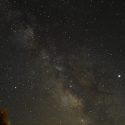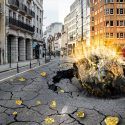Welcome to Scotland.The home of malt scotch, kilts, and sea monsters? It’s time to get up close and personal with the Loch Ness monster, affectionately known as Nessie. WHAT SPECIES IS SHE? WHAT DOES SHE EAT? HOW WOULD LIFE CHANGE IF WE FOUND HER?
The Loch Ness monster is said to be a giant marine creature residing in Loch Ness, Scotland.Reports of Nessie go all the way back to 565 CE. But she became an international sensation in 1934, when physician Robert Kenneth Wilson shot this iconic photo. Reported to be about 2.5 m (8 ft) long, Nessie is said to resemble a “dragon or prehistoric monster.Rumors even suggest that she’s a plesiosaur, a marine reptile that went extinct around 65.5 million years ago.
So if Nessie really is swimming around the loch, what kind of animal would we be dealing with?
Well, our bet isn’t on some sort of prehistoric creature, but a giant eel. And if Nessie is a sort of giant eel, chances are she would be carnivorous.This means she would consume the fish native to the lake and any small invertebrates she could get.
Nessie could chow down on pike, trout, sticklebacks, minnows, charr, and other creatures native to the lake. Maybe, if she were large enough, she would feed on some unlucky deer or otters that took a dip in the lake. But enough about the loch dwellers. How would the discovery of the Loch Ness Monster change human lives? I mean, how would we even go about dealing with something like that?
Well, we don’t have to guess, because the Scottish government has an official plan in place. In 2001, the Scottish Natural Heritage agency, now called NatureScot, prepared a code of practice if anyone were to find the creature.
Specifically, the document says that a DNA sample would be taken from the monster to identify her once and for all. Oh no. Are they going to experiment on poor Nessie? Thankfully, no. The code states that after taking the DNA sample, Nessie will be released back into the loch.
To sweeten the deal even more, the document also describes that the species — monster or not — would need to be protected from harm.
This is crucial, because once it’s confirmed that the Loch Ness Monster exists, curious searchers would be joined by hunters and poachers.
We can only imagine what a taxidermied Nessie would go for on the black market. So, how would a protected Nessie repay the people of Scotland? Well, the Loch Ness Monster would undoubtedly become something a golden goose. The Loch Ness monster contributes almost £41 million (Peter, 41 million British pounds) (U.S. 54.6 million) to the Scottish economy every year. If you could see the monster, we could expect that figure to skyrocket.
The tourist industry in Loch Ness would change dramatically. Maybe there would be Loch Ness tours, just like whale watching tours?
Even without evidence, the legend of Nessie brings the tourists in, in droves. They support hotels, souvenir shops, and the local economy as a whole. With a real Nessie in the loch, the economy would boom.
The downside of that is, all that attention may overwhelm the area. And more importantly, it might overwhelm Nessie’s ecosystem. It’s possible that the area would need to be restricted to a certain number of people at a time. Sort of like a safari, with humans not interacting with or disturbing the animal.
So is it possible that Nessie may really be out there?
There’s always a chance of discovering a new species. I mean, there was a time when people thought the platypus and the komodo dragon were the stuff of legend.The good news is, if Nessie is out there, Scotland has her back. But this has us thinking. If Nessie is real, that means some other big contenders are too.
Sources
- “Loch Ness Monster | History, Sightings, & Facts“. 2020. Encyclopedia Britannica.
- “Loch Ness Monster May Be A Giant Eel, Say Scientists“. 2019. BBC News.
- “Loch Ness | Location, Depth, & Facts“. 2020. Encyclopedia Britannica.
- “Loch Ness Monster Worth Nearly £41M A Year To Scottish Economy | Press And Journal“. 2020. Press And Journal.
- “The Loch Ness And Loch Ness Monster Information And Research Site – Fish And Other Vertebrates“. Harmsworth, Tony. 2020. Loch-Ness.Org.
- “Facts About Eels For Kids“. 2020. Sciencing.
- “Loch Ness Monster: Is Nessie Just A Tourist Conspiracy?“. 2013. BBC News.



























